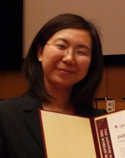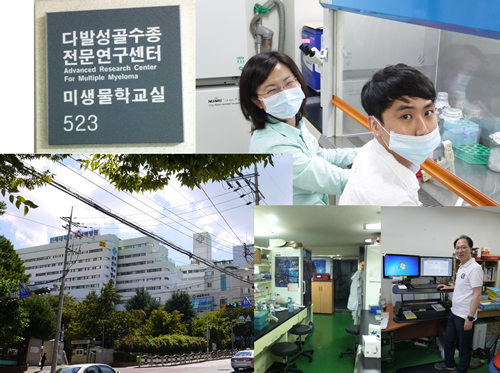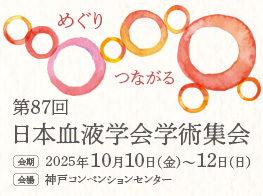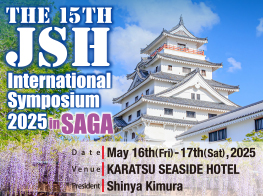
Yasuko Hamada
Division of Hematology, Department of Medicine, Nippon Medical School
Host supervisor/Mentor of the project: Inhak Choi, MD, PhD
Department of Microbiology and Immunology, Director of the Advanced Research Center for Multiple Myeloma, Inje University College of Medicine
Home mentor: Hideto Tamura, MD, PhD
Division of Hematology, Department of Medicine, Nippon Medical School
Research Project
New treatment strategy for myelodysplastic syndromes by targeting VSIG4, a negative regulator of T-cell activation, expressed on blasts
GENERAL REPORT
1. Host institution: Inje University College of Medicine
Inje University is based at Paik Hospital, the first civil nonprofit organization in Korea. The founding values of Inje University are Insuljese and Indeokjese, meaning "Save the world through the healing arts" and "Save the world through benevolence and virtue," respectively. The founding values of Nippon Medical School are Saisei-kyumin, meaning "Save people's lives," and Kokki-junko, meaning "Serve the public and disregard oneself." I feel a strong connection with those values.
The laboratory where I spent all my time is in the Department of Microbiology and Immunology and called the Advanced Research Center for Multiple Myeloma. The laboratory team consists of Professor Inhak Choi, one assistant professor, five researchers, and three graduate students. The friendly, positive, enthusiastic attitude of the team members was similar to that in Japan. They conduct various experiments on both hematological malignancies and other solid cancers. They focus on immune checkpoint pathways, especially on B7 family proteins, including my research focus V-set and immunoglobulin domaining-containing 4 (VSIG4).
The center is a part of Busan Pail Hospital, located in the Busan-Gyeongnam area on a hillside. There is a hiking course at the top of the hill, and I enjoyed hiking after lunch with my mentors Dr. Choi and Dr. Jung while viewing the Busan Mountain range. Busan is South Korea's second-largest metropolis after Seoul, with a population of approximately 3.6 million. The city is located on the southeastern-most tip of the Korean Peninsula. It takes only two hours to fly from Tokyo to Busan. On a clear day, the Tsushima Islands can be seen in the distance. People compare "Busan and Seoul" with "Osaka and Tokyo." People in Busan are kindhearted, and the streets are busy. Busan is a beautiful city surrounded by mountains and near the beautiful sea, allowing residents to enjoy fresh seafood and vegetables gathered from the mountains. As everyone knows, Korean cuisine is delicious. I was there for only two weeks but enjoyed the Korean lifestyle very much.
2. My research theme: VSIG4 in MD
1) Background
Myelodysplastic syndromes (MDS) are heterogeneous disorders characterized by inefficient hematopoiesis, peripheral blood cytopenia, and increased risk of progression to acute leukemia. Although allogeneic stem cell transplantation is the only potentially curative treatment, most MDS patients are elderly and not eligible for that intensive treatment. Azacitidine, which significantly prolongs overall survival compared with conventional treatment regimens, is the current standard of care in high-risk MDS but is not curative. Thus, groundbreaking new treatment that is more effective but less intensive for MDS patients is eagerly anticipated.
Our research group and others reported various immune abnormalities including lymphopenia, T-cell dysfunction, and increased T-cell apoptosis in MDS. Immune dysregulation was reported to be associated with disease progression. We demonstrated that the co-inhibitory molecule B7-H1 (CD274, PD-L1) expressed on MDS blasts induced apoptosis of tumor-specific cytotoxic T lymphocytes (CTLs) and was associated with progression to leukemia [Kondo A, et al. Blood 2010, Ogata K, et al. Leuk Res 2012]. These data indicate that not only genetic abnormalities but also aberrations in the immune response may play a crucial role in the pathogenesis of MDS. It is important to elucidate the detailed mechanism of immune dysfunction in MDS, and such studies will lead to the development of new treatments resulting in the recovery of the antitumor immune response based on the blockade of negative signals from co-inhibitory molecules such as B7-H1 on MDS blasts to T cells.
VSIG4, a newly identified B7 family-related protein, is mainly expressed on monocytes and a strong negative regulator of T-cell proliferation and interleukin-2 production in vitro and in vivo. It was reported that VSIG4 plays a crucial role in the induction and maintenance of liver T- and natural killer (NK) T-cell tolerance in the ConA-induced hepatitis model [Jung K, et al. Hepatology 2012].
2) Purpose
The role of VSIG4 in cancer and hematologic malignancies remains unclear. Therefore, the aim of our study was to investigate the expression and functions of VSIG4 in hematologic malignancies, especially in MDS.
3) Preliminary experiments
Using real-time PCR, Western blotting, and flow cytometry, VSIG4 expression was detected on MDS cell lines and MDS cells from the patients. The anti-VSIG4 antibody for flow cytometry staining was produced and provided by my host mentor Dr. Choi.
4) Studies in Korea based on those results
First, we confirmed the experimental conditions before undertaking joint research. Then, we analyzed the role of VSIG4 expressed on tumor cells in terms of NK cell activity and antibody-dependent cell-mediated cytotoxicity. Next, we determined whether VSIG4 on MDS cells inhibits T-cell immune responses and allogeneic mixed lymphocyte reactions, for which analysis using VSIG4+ MDS cell-specific CTLs was performed. To investigate whether VSIG4 is released into the peripheral blood, soluble VSIG4 was measured in serum from MDS patients using an ELISA system. The collaborative research is currently continuing in Japan and Korea, and I plan to report the results in the near future.
3. Summary of the Fellowship Exchange Program
The award period is for a maximum of three months. However, I could only take up to two weeks because I am a working clinical hematologist and my schedule does not allow sufficient time to conduct extensive experiments in Japan. This short-term stay was therefore a valuable time for me to concentrate on experimental research. Discussing the experiments in English was also an invaluable experience. This program is a useful opportunity for young hematologists to widen their horizons. The JSH and KSH Foundation entrusted me with the mission of promoting a prolonged friendly relationship between our two countries. The physicians associated with the KSH worked to convey the message that "We hope you have a wonderful time in Korea." I am convinced that I was able to achieve the mission and was fortunately able to get a start in conducting joint research. Moreover, I was attracted to Korean culture and will certainly return to Busan.
For people given the opportunity to study abroad, the language barrier might be the biggest challenge. I cannot speak Korean, so I had some anxiety. I memorized hangul (the Korean syllabic writing system) before going to Busan and was surprised by how easy the structure and patterns were to learn. If I could give one piece of advice to the next candidates for this program, it would be that they should learn how to read hangul and say a few key phrases to make everyday Korean life more rewarding. I learned from my experience that appreciating our differences is the most important element in mutual understanding. Dr. Choi and the other team members were pleased that I enjoyed Korean food and culture, and they recommended many new things for me to try in quick succession. I sincerely hope that young Korean physicians can also come to Japan so that we can learn from each other.
4. Acknowledgments
First and foremost, I am very grateful to Prof. Inhak Choi. He made me welcome in his laboratory and helped me in numerous ways as a thoughtful person and knowledgeable teacher. I would also like to thank Assistant Prof. Jung Keunok and the staff of the Advanced Research Center for Multiple Myeloma. All of them welcomed me, and I will never forget the farewell BBQ feast and evening of games. I also appreciate the cooperation and understanding of the senior physicians of the Division of Hematology, Department of Medicine, Nippon Medical School and Yokohama Minami Kyousai Hospital, during my two-week absence. Finally, I would like to express my gratitude to the Japanese Society of Hematology and Korean Society of Hematology for giving me this precious opportunity.




